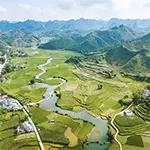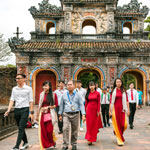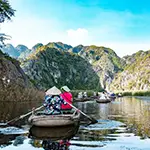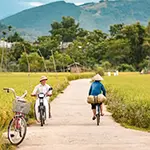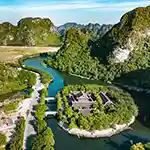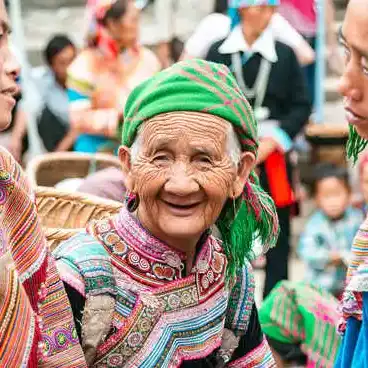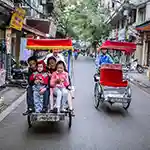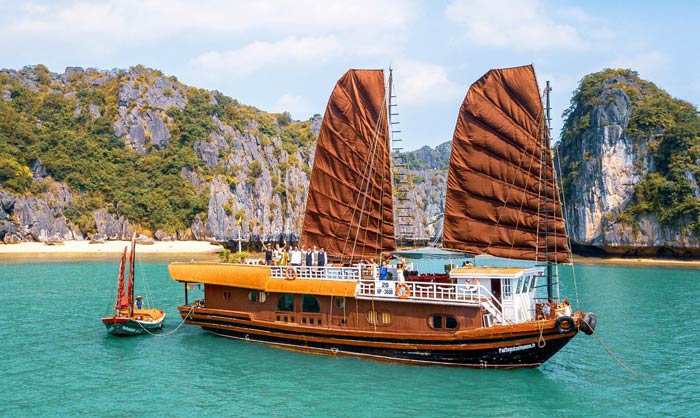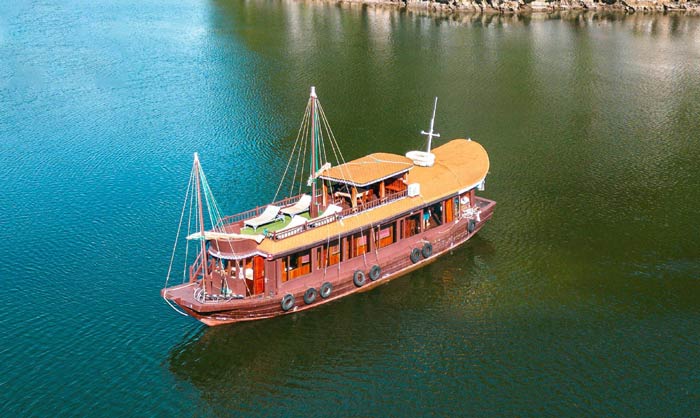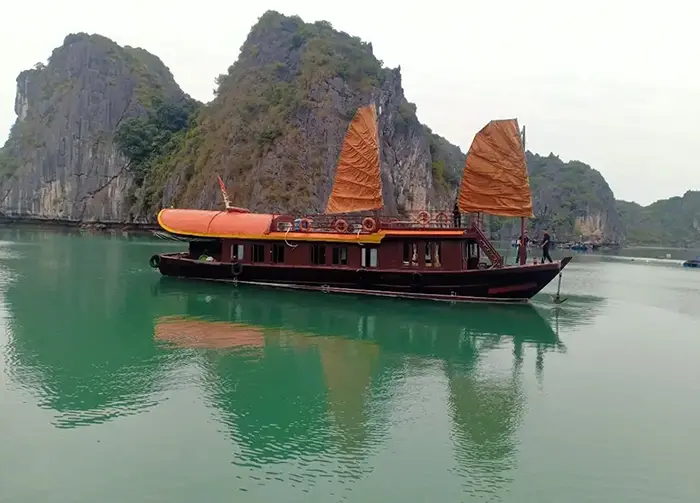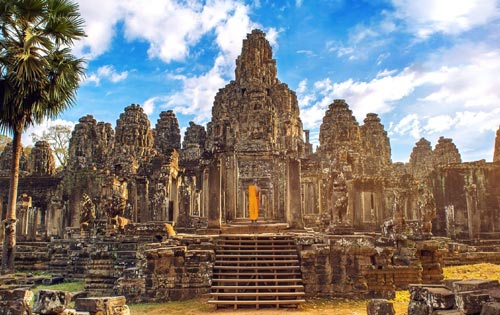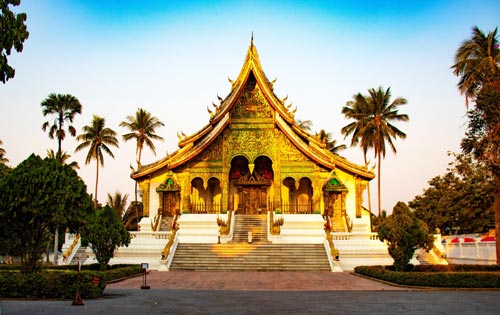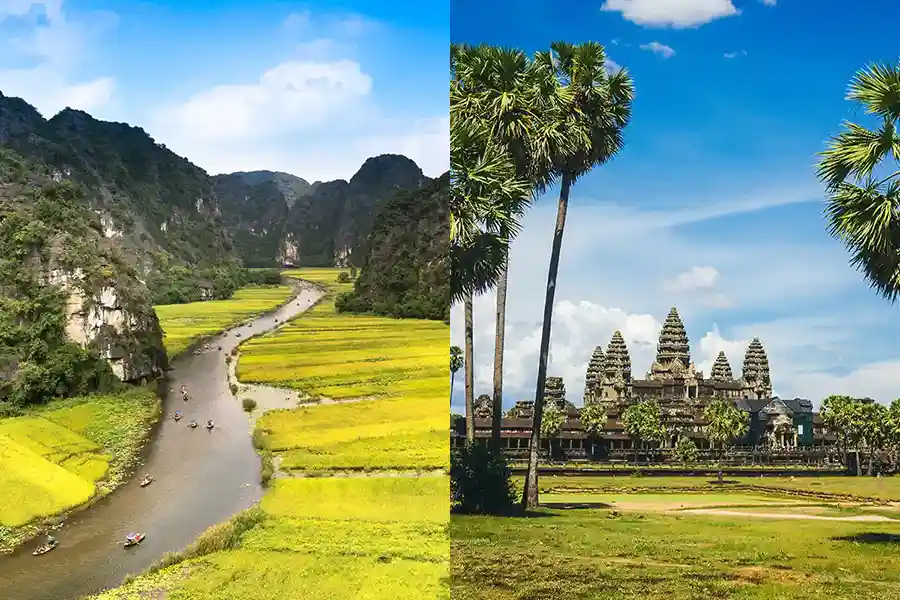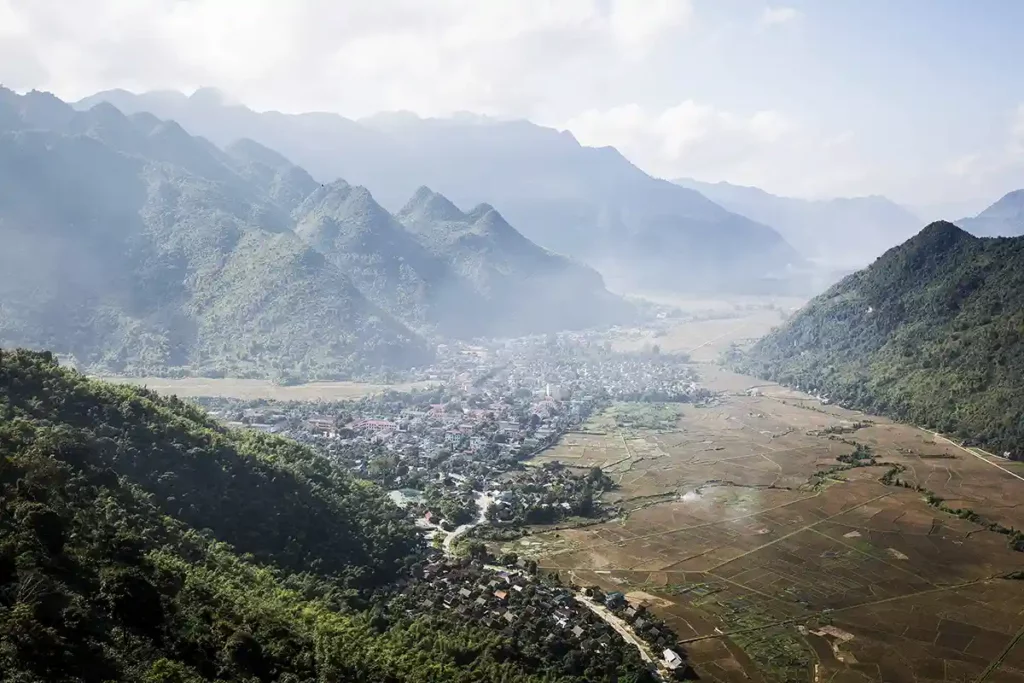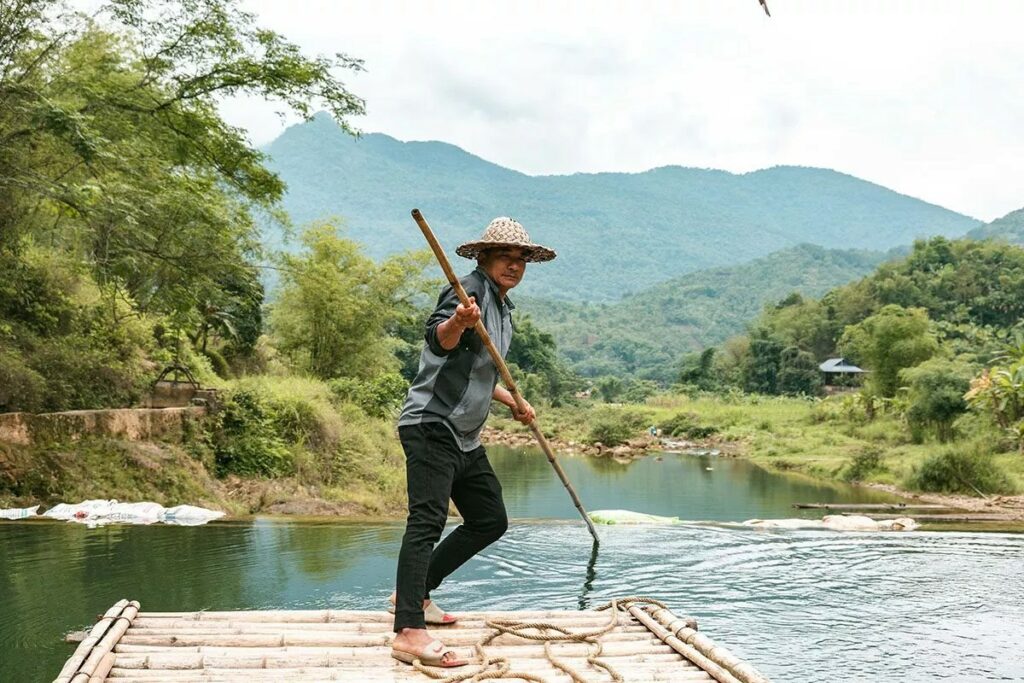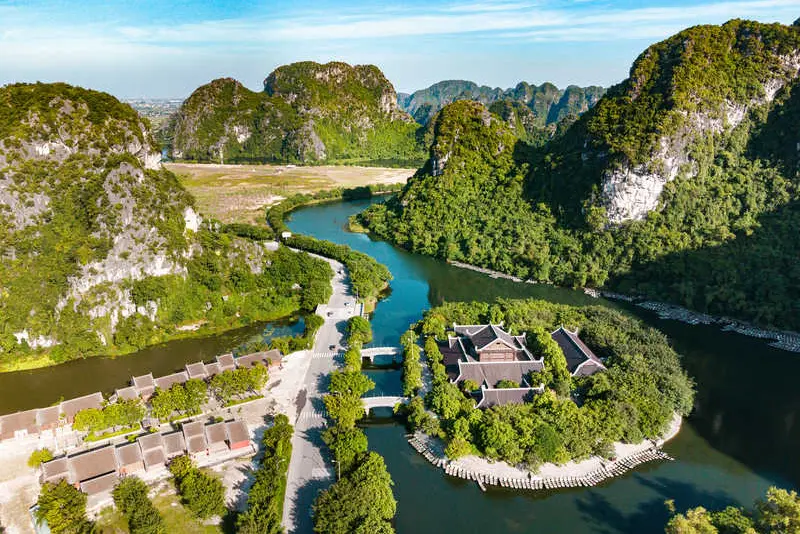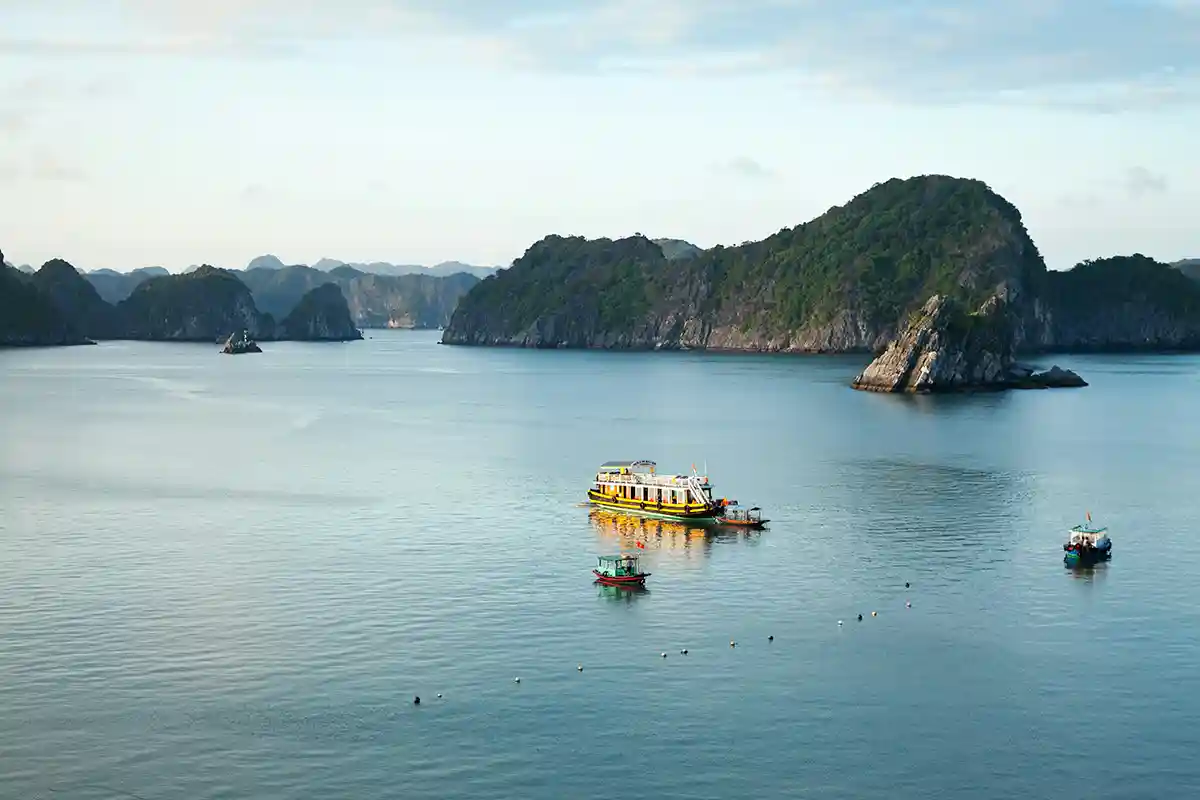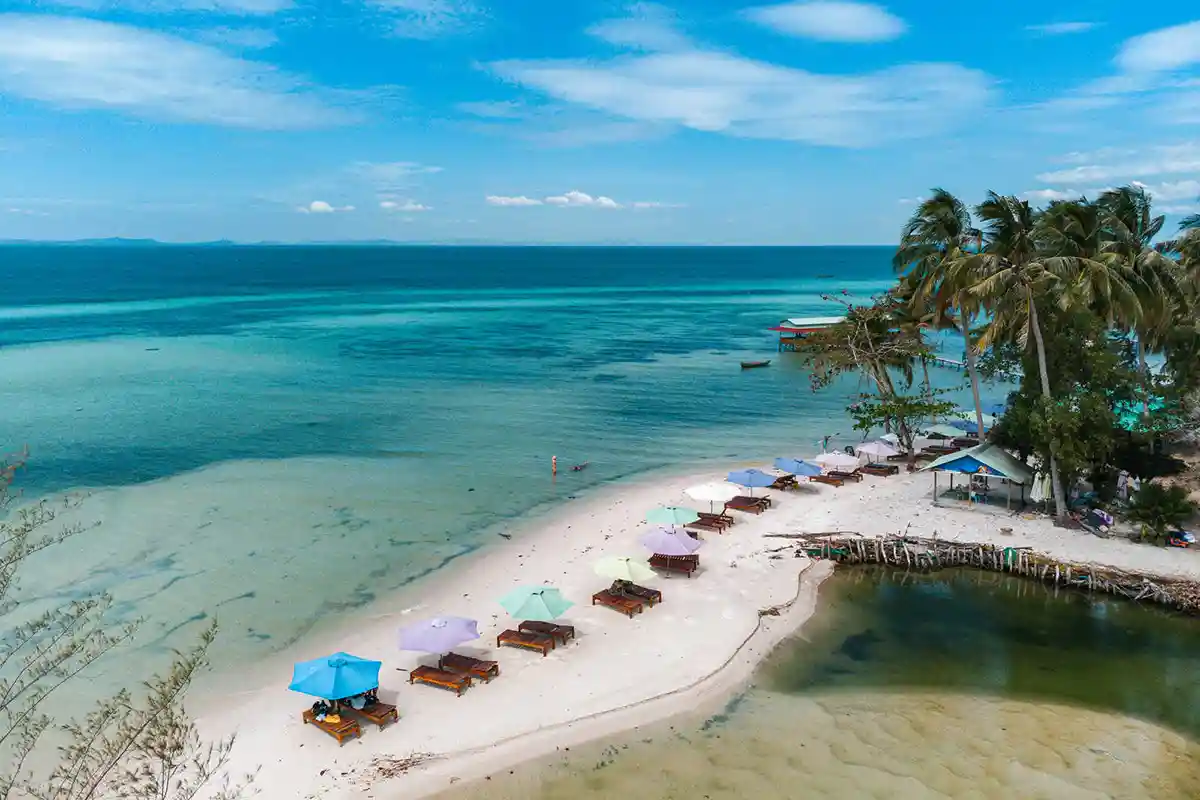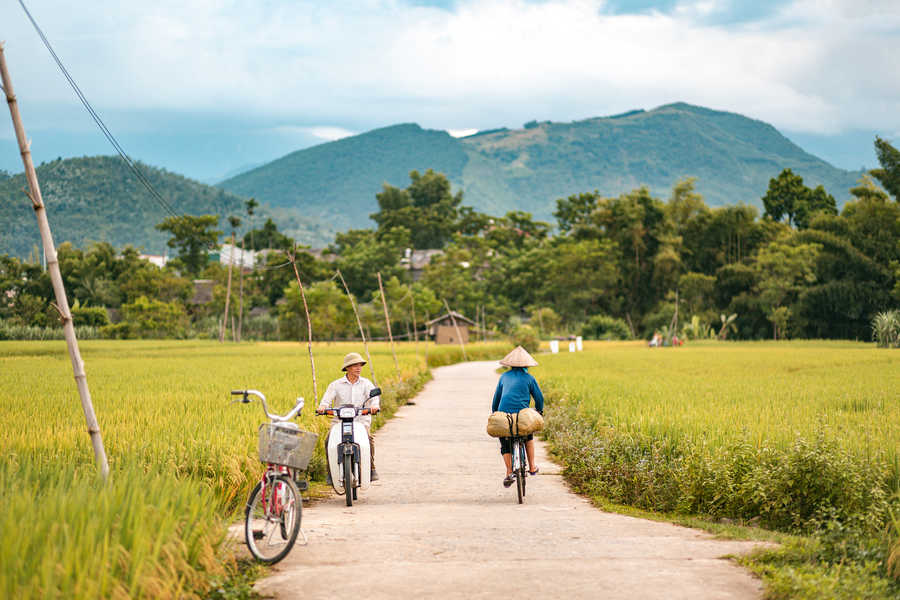Are you planning a trip to Vietnam but not sure where to go or what to prioritize? In this article, we explain the main differences between Northern and Southern Vietnam, so you can decide which region to visit first.
If you prefer to get a tailor-made suggestion, feel free to request your personalized itinerary with our local travel agency in Hanoi.
Overview of the two regions
Vietnam is increasingly attracting travelers eager to discover its cultural richness, breathtaking landscapes, and delicious cuisine. However, planning a trip to this fascinating country can be challenging, given its incredible diversity in both culture and geography. Among the questions that often arise for travelers, the choice between Northern and Southern Vietnam is crucial. Each of these regions offers unique experiences, hidden treasures, and a distinct atmosphere.
Northern Vietnam is characterized by its traditional atmosphere, mountainous landscapes, and cultural richness. Iconic cities like Hanoi provide a unique blend of French colonial charm and ancient Vietnamese traditions. The region also boasts spectacular natural sites, such as Ha Long Bay with its majestic karst islands and Sapa with its terraced rice fields and tribal villages. On the other hand, Southern Vietnam, with dynamic cities like Ho Chi Minh City, offers a more modern and urban vibe. The region stands out for its skyscrapers, lively street food scene, and influence from the Vietnam War. The Mekong Delta, a fertile and picturesque region, is also a distinctive feature of the South. These differences create unique experiences for travelers, inviting them to choose based on their preferences and what they seek in their journey.
In this article, we will explore the characteristics of Northern and Southern Vietnam to help you make an informed decision for your next adventure in this enchanting country. Whether you are drawn to the tradition and majestic nature of the North or the urban buzz and picturesque landscapes of the South, get ready to immerse yourself in the heart of an unforgettable Vietnamese adventure.
Northern Vietnam, Spectacular Landscapes, and Cultural Richness
We will describe here three destinations that perfectly symbolize the charm and diversity of what can be seen in Northern Vietnam: Hanoi, Ha Long Bay, and Sapa.
Hanoi, the historical capital
Hanoi, the capital of Vietnam, is a fascinating city filled with history, charm, and unique cultural experiences. Here, we will explore the various facets of this dynamic city and introduce you to the must-visit attractions as well as enriching experiences it offers.
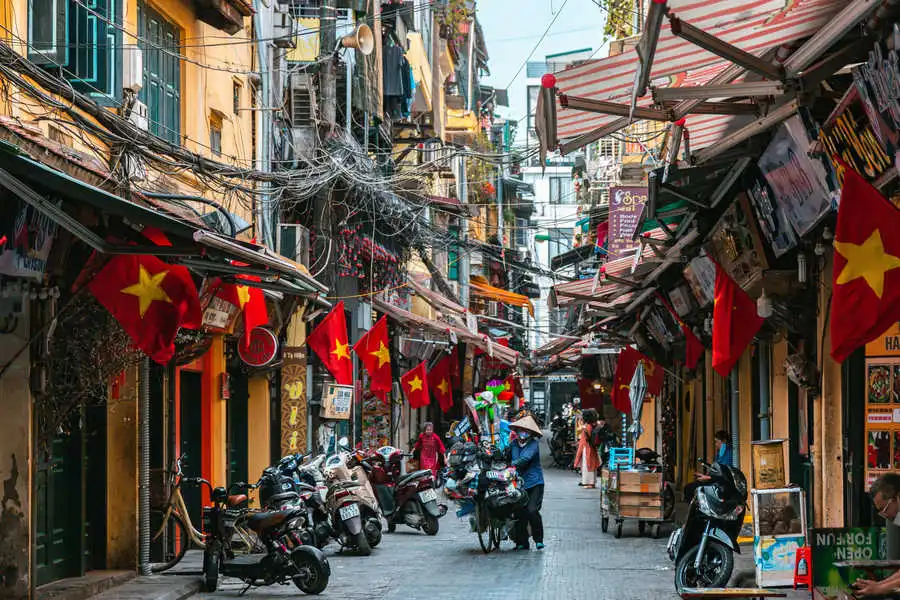
Ta Hien street in Hanoi. Crédit : Mathieu Arnaudet/Parfum d’Automne
The charm of the Old Quarter and its bustling alleys
Hanoi’s Old Quarter is a true gem where a lively and colorful atmosphere prevails. Its narrow alleys, lined with traditional houses and vibrant shops, provide an authentic glimpse into daily life in the city. Strolling through these picturesque lanes is an experience in itself, where one can discover small markets, craft shops, and street restaurants offering delicious dishes.
Hoan Kiem lake and the Temple of Literature
Located in the heart of Hanoi’s Old Quarter, the Hoan Kiem Lake, or Lake of the Restored Sword, is one of the most iconic places in the city. According to legend, a turtle returned a sacred sword to the Vietnamese emperor Le Loi here, hence the lake’s name. You can stroll along the lake, enjoy the lively atmosphere, and admire the picturesque views. There is also a temple in the middle of the lake, called the Turtle Temple, adding a cultural touch to this must-visit. The Temple of Literature, on the other hand, is a beautiful architectural complex dedicated to the veneration of Confucius and Vietnamese scholars. It is a place of serenity and beauty.
Water puppet show and local food
Hanoi also offers unique cultural experiences that will immerse you in the heart of Vietnamese life. Water puppet shows are a fascinating traditional art form where wooden puppets come to life on a water stage. It’s a captivating performance that tells traditional Vietnamese stories. Additionally, Hanoi’s cuisine is renowned for its delicacy and unique flavors. Don’t miss the opportunity to taste local dishes such as the famous “phở” (noodle soup), “bánh mì” (Vietnamese sandwiches), or “cha ca”.
Halong bay, a natural wonder
Let’s change from the urban to the natural with the discovery of the marvelous Halong Bay.

Floating villages in Halong bay. Crédit : Mathieu Arnaudet/Parfum d’Automne
The spectacular karst formations and boat cruises
Halong Bay is renowned for its majestic karst formations, rising from the emerald water like a fairy-tale scene. These limestone islands with peculiar shapes create a breathtaking landscape, offering panoramic views at every turn. The best way to explore the bay is by joining a boat cruise. This allows you to peacefully sail through the islands, discover hidden caves, and marvel at the natural beauty surrounding you.
Water activities, swimming and kayaking
Ha Long Bay offers a multitude of exciting water activities. Kayaking is one of the best ways to explore the remote corners of the bay. You can paddle along the cliffs, weave through natural arches, and discover hidden lagoons. Swimming is also a refreshing experience, allowing you to relax in the crystal-clear waters while admiring the stunning landscape around you.
The floating villages of Lan Ha bay
Lan Ha Bay is located near the famous Halong Bay. What sets it apart from its neighbor is its preserved and less touristy atmosphere. Organizing a junk boat cruise in Lan Ha Bay offers an authentic experience, with spectacular karst landscapes, secluded beaches, and picturesque floating villages. Cat Ba Island, located in the bay, is the only place where small traditional boats can still be found, adding a touch of charm and uniqueness to the exploration of this natural wonder. You will also encounter floating villages inhabited by local fishermen, these communities live in harmony with nature and rely on the sea for their livelihood.
Sapa, spectacular landscapes and ethnic minorities
Another must-visit destination in Northern Vietnam is Sapa and its surrounding villages where ethnic minorities shape the mountains into spectacular terraced rice fields.
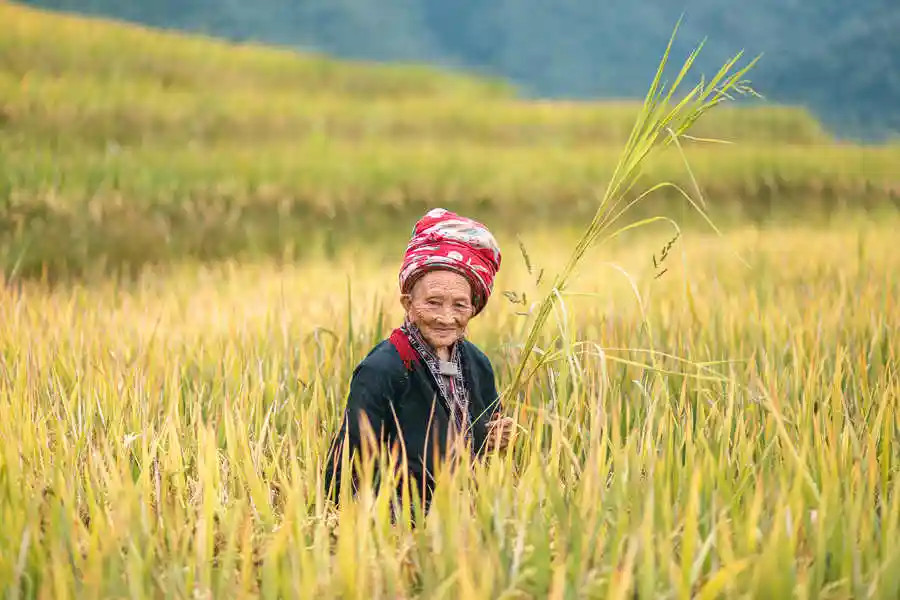
Dao woman around Sapa. Crédit : Mathieu Arnaudet/Parfum d’Automne
The beautiful paddy fields
Sapa is famous for its picturesque terraced rice fields, providing breathtaking views. The green hills and snow-capped peaks in winter create a spectacular landscape that attracts photography enthusiasts and nature lovers.
Hiking and meeting local population
Sapa is surrounded by numerous tribal villages where different ethnic communities, such as the Hmong, Dao, and Tay, reside. Hiking through these villages can be moderately challenging due to the mountainous terrain, but it is worth every effort. While trekking the trails, one can observe local residents working in the terraced fields, practicing traditional agricultural techniques.
Culture of ethnic minorities
Sapa provides an exceptional opportunity to explore the cultural richness of Vietnam’s ethnic minorities. You can take part in traditional festivals, attend folk dance performances, and learn local crafts such as weaving and embroidery.
Southern Vietnam, between urban bustle, culture, and relaxation
In the southern part of the country, you’ll find the most dynamic city, Ho Chi Minh City, as well as paradisiacal islands like Phu Quoc or Con Dao, the Mekong Delta, and charming cities like Dalat.
Ho Chi Minh City, the modern and bustling city
Ho Chi Minh City, formerly known as Saigon, is a captivating destination that provides a complete immersion into the modern urban life of Vietnam. This dynamic city is full of contrasts between its history marked by the Vietnam War and its rapid urban development.
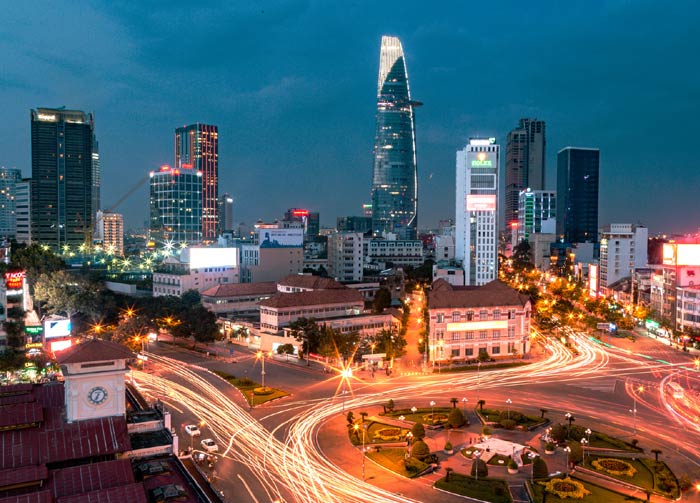
Ho Chi Minh City (Saigon) at night, Vietnam. Crédit : Mathieu Arnaudet/Parfum d’Automne
The history of the Vietnam war through historical sites
Ho Chi Minh City is steeped in the tumultuous history of Vietnam. By visiting historical sites such as the Reunification Palace and the War Remnants Museum, visitors can gain a better understanding of the events that shaped the country. The Reunification Palace, once the seat of the South Vietnamese government, stands as an iconic witness to the history of the war. The War Remnants Museum showcases poignant exhibits on the consequences of this devastating conflict.
Colonial architecture alongside modern skyscrapers
The influence of the French colonial era can be seen in the architecture of some buildings in Ho Chi Minh City. The Saigon Opera House, Notre-Dame Cathedral, and Central Post Office are notable examples of French architectural style. However, the city is rapidly transforming with a multitude of modern skyscrapers dominating the skyline. The iconic Saigon Skydeck offers a breathtaking view of the city and its surroundings from one of the tallest buildings in the metropolis.
Urban exploration : the busy markets and the street food
Ho Chi Minh City is the vibrant heart of urban life in Vietnam. Its bustling streets are filled with lively markets, shops, and quaint cafes. Ben Thanh Market is a must-visit place to experience the hustle and bustle of daily life. Travelers can wander through colorful aisles, taste fresh fruits, and sample local specialties. For food enthusiasts, street food in Ho Chi Minh City is an unforgettable experience. Delicious dishes like Banh Xeo, Bun Thit Nuong, or Goi Cuon can be enjoyed at small street-side stalls.
Mekong delta, a fertile and picturesque region
The Mekong Delta is a region of exceptional natural beauty, renowned for its fertility and picturesque landscapes. Explore this fascinating region to discover the unique treasures it has to offer.

Boat navigating in the Mekong delta, Vietnam
Colorful floating markets
One of the most iconic attractions of the Mekong Delta is its floating markets. Picture boats laden with fresh produce and goods, colorful and lively, floating on the waters of the Mekong. These markets provide a unique visual and olfactory experience, where you can buy fresh fruits, vegetables, spices, and many other local products. It’s the perfect opportunity to immerse yourself in the vibrant atmosphere and meet the warm-hearted locals of the region.
Boat rides along the tranquil canals
The Mekong Delta is crisscrossed by a complex network of canals, creating a labyrinth of tranquil waterways. Embark on a boat ride and let yourself be guided along these serene water paths. You will be amazed by the beauty of the landscapes, coconut trees leaning over the water, and the picturesque villages lining the shores. Don’t miss the spectacular acrobatics of the rowing boats, where local artists perform incredible feats on their traditional vessels.
Discovering the rural life
The Mekong Delta is the rice bowl of Vietnam, and rural life is very prominent there. Explore traditional villages and agricultural landscapes, where you can observe traditional farming techniques in action. You can see farmers working in the rice fields, cultivating exotic fruits, and raising livestock. It’s a unique opportunity to learn more about Vietnamese agriculture and to have an authentic experience by participating in agricultural activities.
Phu Quoc and Con Dao, paradise islands
The islands of Southern Vietnam are, of course, a unique feature since you won’t find such paradisiacal landscapes in the northern part of the country. They are perfect for a beach extension at the end of your journey.
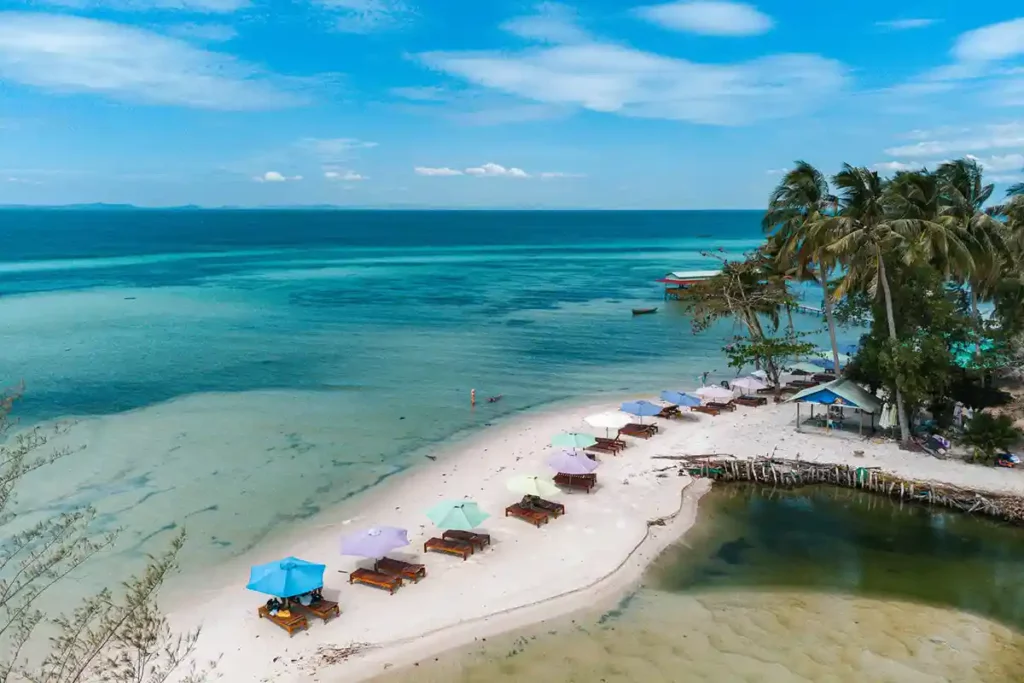
Phu Quoc islands
Phu Quoc, the pearl island
Located at the southernmost tip of Vietnam, Phu Quoc is the country’s largest island. Acquired relatively recently by the Vietnamese people (apparently in the mid-19th century), the island is administratively part of Kien Giang Province.
So what to do in Phu Quoc? First and foremost, relax and enjoy the beaches. We can recommend Bai Truong Beach on the southwest coast, Bai So and Bai Dam on the southeast, as well as the wild coves of Bai Ong Lang in the north. It is now possible in several places on the island to organize scuba diving sessions for coral enthusiasts. The water is warm and shallow, allowing you to discover tropical fish and colorful reefs all year round!
Phu Quoc also has a natural park, and we recommend taking a forest walk in the north of the island. Other activities are also possible, such as visiting a Cao Dai temple built in 2008 or exploring farms producing pepper or pearls, etc.
Con Dao, the small paradise island
The Con Dao Islands are an archipelago of 16 islands, but only one of them is inhabited: Con Son.
Despite being a paradise today, the island had a less glorious past. Renamed “Poulo-Condor Islands” by the French colonizers, the island hosted one of the main prisons in Indochina from 1862. It was used to imprison political opponents. You can visit the remnants of some prisons (such as the Phu Tuong camp or Phu Hai prison).
If you don’t believe in ghosts (many Vietnamese people avoid going there due to fear of bad spirits), you will still enjoy your stay on this island surrounded by beautiful beaches: Lo Voi near the city center, Dam Trau in the north of the island. Other beaches and coves are less accessible, such as Ong Dung and Dam Tre Bay.
Con Dao is an ideal place for diving! Beautiful corals surround the island, and you can see colorful fish, turtles, and maybe even dolphins!
Con Dao Island also hosts a 20,000-hectare national park where you can enjoy some beautiful hikes. The park entrance fee is 60,000 VND (2.5 USD) per person. At the Park Office, you can get a map of hiking trails in English.
Dalat, the charm of the Highlands
Dalat, located in the Highlands of Vietnam, is a destination that enchants travelers with its unique charm. This picturesque city offers a refreshing escape from the heat of the South and is full of natural wonders and romantic landscapes.
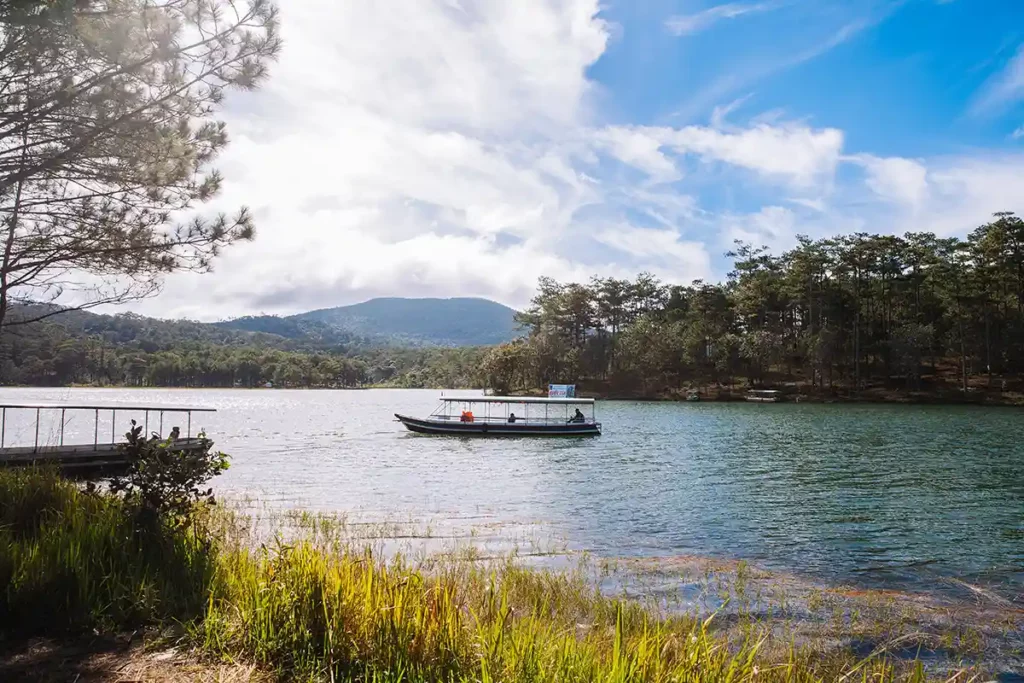
Quiet landscape in Dalat. Crédit : Mathieu Arnaudet/Parfum d’Automne
The cool and pleasant climate, escaping the heat of the South.
Dalat enjoys a cool and pleasant climate throughout the year, making it a perfect escape from the stifling heat of Southern Vietnam. The milder temperatures and refreshing breezes make Dalat a haven of freshness, ideal for rejuvenation and relaxation.
The picturesque tea and coffee plantations
Dalat is renowned for its beautiful tea and coffee plantations, which provide breathtaking landscapes. You can stroll through the green plantations, admire the symmetrical rows of tea bushes and coffee plants, and even take guided tours to learn more about the cultivation and production of these delightful beverages.
Beautiful waterfalls
Dalat is full of majestic waterfalls and romantic landscapes. Pongour, Datanla, and Prenn waterfalls are among the most famous, offering breathtaking panoramas and a serene atmosphere. The hilly landscapes, peaceful lakes, and flower-filled gardens add a touch of romance to this charming city.
Dalat is truly a gem of the Vietnamese highlands, offering a perfect blend of pleasant climate, picturesque landscapes, and authentic experiences. Whether you want to relax in the midst of nature, explore tea and coffee plantations, or simply be captivated by the romantic charm of the region, Dalat is sure to enchant you at every turn.
Commonalities and differences between Northern and Southern Vietnam
Here are some points of comparison between the north and the south of Vietnam in terms of history, cuisine, and climate.
Vietnamese history and culture
Separated by 1,500 kilometers, North and South Vietnam have experienced different influences in their history. Here is an overview.
Chinese and French influences in North Vietnam
Vietnam has been influenced by China for centuries, and more recently by French colonization, which is reflected in the country’s culture, architecture, and cuisine. However, the French influence is more pronounced in the North, especially in Hanoi. Traces of this influence can be seen in colonial architecture and the presence of historical buildings.

Long Bien bridge from Serein cafe. Crédit : Mathieu Arnaudet/Parfum d’Automne
More ethnic diversity in the North
Vietnam is composed of numerous ethnic communities, each with its own language, culture, and traditions. Although this diversity is present throughout the country, it is more pronounced in the North, where a greater variety of ethnic groups can be found.
Vietnamese cuisine
The differences are also, of course, reflected in the cuisine of each region. Here are some major differences.
Regional differences in flavors and ingredients
The flavors of Vietnamese cuisine vary from region to region. In the North, dishes tend to be saltier, while in the South, they are spicier and sweeter. The ingredients used also differ, with a preference for seafood in the South and vegetables and pork in the North.
The most famous dishes from the North and South
Vietnamese cuisine is renowned for its freshness, balanced flavors, and aromatic herbs. Iconic dishes from the North, such as phở and bún chả, are often simpler and focus on delicate flavors. In the South, dishes like bánh xèo and bánh mì are spicier and sweeter.
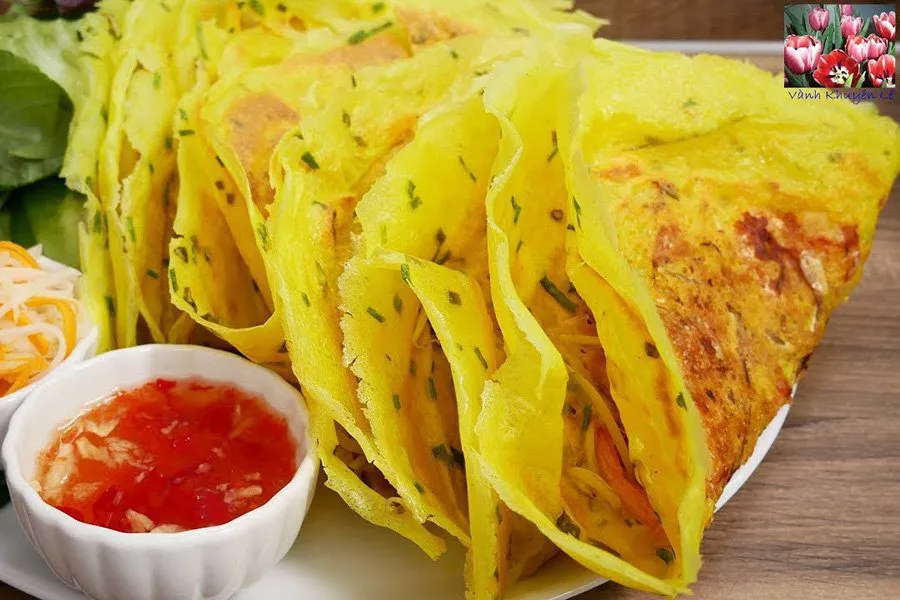
Banh Xeo, typical Southern dish
Climate and seasons
One of the significant differences is, of course, the climate. Here’s what you need to know.
Climate variations between North and South
The climate in Vietnam varies significantly from one region to another. The northern part of the country, including Hanoi, experiences four distinct seasons with cold winters and hot summers. On the other hand, the South has a tropical climate throughout the year, with warm temperatures and higher precipitation.
Best time for visiting each region
Due to climatic differences, the best times to visit the North and South of Vietnam vary. Spring and autumn are generally considered the best seasons to visit the North when the weather is milder. For the South, the period from November to April is ideal, with cooler temperatures and less rainfall.
In conclusion, the choice between the North and South of Vietnam will depend on the individual preferences of travelers. The North offers a traditional atmosphere, spectacular mountainous landscapes, and deep cultural richness. Hanoi, with its French colonial charm and must-see attractions, is a captivating city to explore. Halong Bay and Sapa offer natural wonders, authentic tribal villages, and immersion in the culture of Vietnamese ethnic minorities.
On the other hand, the South of Vietnam stands out for its urban ambiance, Vietnam War history, and lively street food scene. Ho Chi Minh City, with its mix of colonial architecture and modern skyscrapers, provides a dynamic urban experience. Historic sites and bustling markets allow travelers to delve into the history and daily life of the city.
Whichever region is chosen, Vietnam promises unforgettable experiences. From bustling cities to spectacular natural landscapes, each region has its own magic to discover.
It is also possible to combine all regions in a longer journey to enjoy the diversity of the country as a whole.
Ultimately, whether you opt for the North with its tradition and majestic nature, or the South with its urban dynamism and agricultural landscapes, Vietnam offers you an adventure rich in cultural discoveries, authentic encounters, and memorable moments. Whatever your choice, get ready to be amazed by the beauty and diversity of this enchanting Southeast Asian country.

